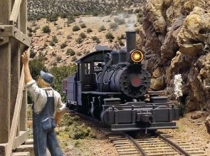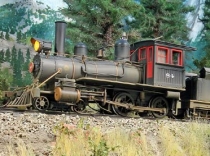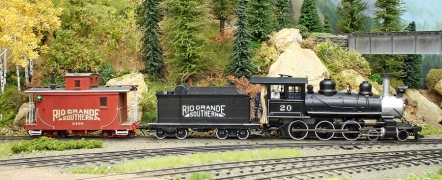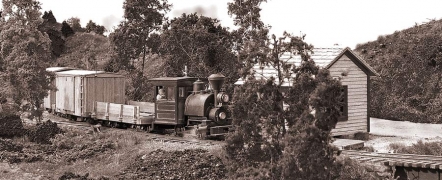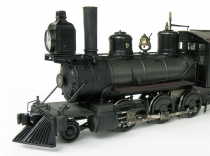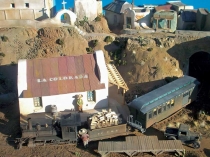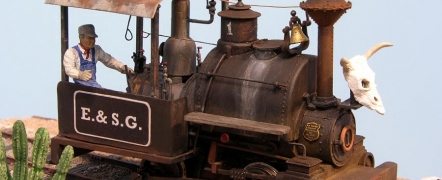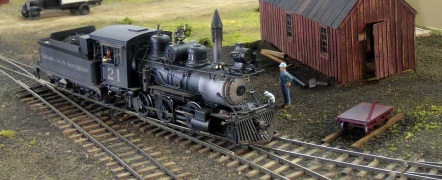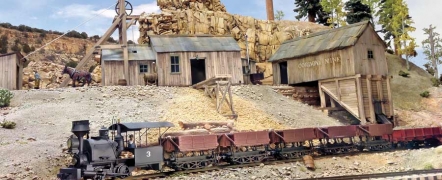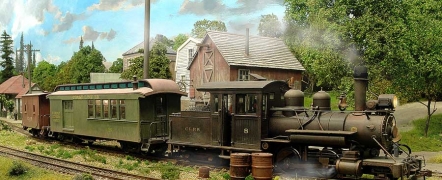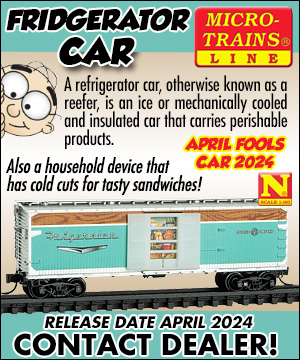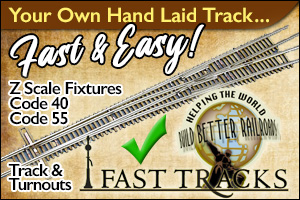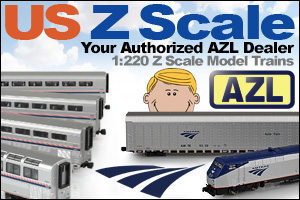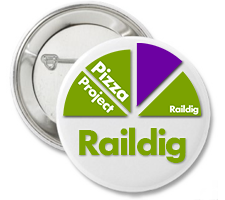Chris Lane, Editor | Carstens On30, HOn3 Annuals
 For someone brand new to or just curious about On30, what do you feel are On30’s biggest strengths, its main appeal?
For someone brand new to or just curious about On30, what do you feel are On30’s biggest strengths, its main appeal?
The main appeal is that it allows someone with an interest in narrow gauge to dip their toe in the water and see if it is for them, without a huge commitment of time and resources. Heretofore, narrow gauge modeling was regarded as a bastion of expert and experienced modelers, a cadre of the “best of the best” if you will, and that thinking was not totally without merit. The supply of products was pretty limited, you needed some modeling skill and experience to put them together and motive power was very pricey.
Narrow gauge itself has always been pretty popular and there was a huge latent interest, but the bar for entry was set relatively high. When Bachmann brought out the first On30 products that bar dropped much lower, and people with an interest but previously felt that the skill or the cost was too high for them, could now try narrow gauge out.
On30 has a number of strengths. First, it is O scale, so the detail is large and apparent and yet, the size of the cars and locomotives themselves are still modest. A Bachmann boxcar is 6 ¼” long which is the same as a scale 45’ boxcar in HO. But it is taller and wider and so has form factor that fits nicely in your hand.
The next greatest strength is it runs on any HO track. Specialized narrow gauge track can be hard to come by or you have to lay it yourself. This is not needed for On30 and that allows the modeler to get running trains quickly, using materials they may already have. Related to the slightly narrower track gauge is the ability to go around sharper curves. There have been a number of locomotives released in the last few years in both On3 and On30 versions. The On30 versions will go around a radius that is between 4″ and 6” less, depending on the locomotive. Now, that may not seem like much, but if you think about that in terms of turnback curves, that is a lot of space saved. Rule of thumb minimum radius for On3 is 36” so the turnback needs 6 feet plus a bit on each side for scenery and to keep trains off the floor. In On30, the exact kind of equipment would run on 28” so you’d need just over 4 1/2′ feet to turnback; quite a difference.
And of course most On30 equipment operates on much smaller radiuses than that from 20 down to 18”. The little stuff like Bachmann’s Porters and small 4-wheel cars will do 9” all day long! Plus On30 is narrow gauge, and narrow gauge, regardless of the specific gauge, has a tremendous amount of character and appeal.
Bachmann appears to produce the majority of On30 RTR locomotives. Is this correct, and do you feel there are specific upsides and/or downsides to this?
No question, Bachmann is the largest producer of On30 equipment by quite a margin. The obvious downside is if Bachmann ever quits making locomotives, the motive power choices become very limited, very quickly. But Bachmann has a huge, long-term commitment to On30 (15 years and counting) and the tooling is not cheap, so it is highly unlikely they will abandon this market anytime soon. Another upside is the locomotives and rolling stock tend to work well with one another as they were designed and built by the same folks, and there is a consistency to the paint, details, finishes etc.
A potential downside is if there is a design flaw, like the tendency for some of the geared locomotives to split gears as they aged, it tends to run through several of the different locomotives. But even this can be viewed as an upside. Because Bachmann is a large company and they had sold quite a few of the locomotives, they recognized that they had a commitment to their customers, so they molded and sent out, free of charge, replacement gears for the affected locomotives.
Being very new to On30, I (very) broadly tend to associate On30 with the western mining or eastern logging, how far off am I with this characterization?
I think those are clearly areas that On30 is used and used to model effectively. In addition, there is quite a number of folks who model what I call “mainline narrow gauge,” which using On30 to model traditional narrow gauges like the Denver and Rio Grande, Colorado & Southern, Tweetsie, East Broad Top and the California narrow gauges.
Let’s wheel out the old chestnut, rivet counting. How prevalent is this in On30? Are there hardcore pro and con camps on rivet counting or do both sides play reasonably well in On30?
First off, I’ve been in narrow gauge in O scale for a very long time, about 40 years, and I find that the On30 guys are by far the most tolerant, easy to get along with bunch I’ve come across. They strongly embrace a “live and let live” ideal and are pretty slow to be critical of other modelers and their ideas. That said, there are probably a few less rivet-counter types in On30 than you might encounter in other scales. That is not to say they don’t exist! I would have to count myself amongst that group. I have always been fascinated by the little fiddly bits and I like to add as many and make my models as accurately as I can. Now obviously, I am willing to trade some accuracy for modeling expedience; that’s why I am in On30 in the first place! I do think one of the key differences is that even those of us who lean towards rivet counting have the good social graces to stick to counting just our own and not the other guy’s rivets.
The thing I’ve found appealing is the sense of fun, whimsy maybe, that seems right at home in On30. In general, do you think this atmosphere extends to the actual layouts?
I think so. If you are having fun with your trains, that is going to extend to the layout. I belong to a round-robin group “The Boomers” and the group includes the On30 layout of the Annual’s Editor-at-Large, Don Strait. Don bought a group of white metal vultures, and we have posed vultures all over the layout: Perched above a telephone lineman, and loitering around some road kill. In a tree above the lone passenger at a flagstop and perched over a couple on lover’s lane. He also found a Bigfoot figure and hid him on the layout. It is a decent sized layout and the game is to find where he is hidden. Sometimes a couple weeks will go by, but once the person finds the figure, he announces that there has been a Sasquatch sighting and then he hides the figure. This has been going on for over 2 years and it is still fun.
How about a little background on you personally Chris, how did you get involved with On30?
As I mentioned earlier, I have been in narrow gauge for over 40 years. Clearly, I was one of the weirdest kids around as I went straight from Lionel into On3. My first two kits were the Simpson 24’ Westside log car and a Mainline Models RGS stockcar. I still have both around here someplace, and the log car still looks pretty good, although that is more of a credit to the skill of the late Russ Simpson’s design than my modeling ability at that age. I modeled in On3 for over 30 years focusing primarily on the Colorado & Southern, but also some Rio Grande.
I had dabbled part-time in the train business for a few years, but started working full-time for the now defunct Model Railroading magazine in 1994. Even before that, I was aware that Bachmann was cooking up something in On30 and I had discussed it with Bachmann’s Lee Riley on several occasions. Sometime in ’95 or ’96, I made a sales call to Bachmann in Philly and was ushered into the “inner sanctum” Lee Riley’s office.
Lee was showing me a number of products, but my eye was caught by a familiar outline of a steam locomotive. Now mind you, this locomotive had a Day-Glo orange pilot and air pump, and the sanders and some other details were molded in lime green, but I recognized the prototype as C&S No. 21 or 22, which were 1880’s vintage Brooks moguls (2-6-0) that were modernized around 1894 with new straight boilers, larger diameter drivers and cylinders and new frames. Lee explained that when they shot test parts in new molds, they used whatever color was in the machine, hence the green and orange detail parts. He also said these were the molds cut a few years earlier we discussed, but the model was on the corporate “back-burner” at the moment, and he’d keep me appraised of its progress.
Now it is certainly not polite to whip out the scale ruler in a client’s office, but just eyeballing the model I could tell it was a pretty accurate rendition, and when I eventually got my hands on production models, that proved to be true. Being a man of his word, Lee presented me at the NMRA National in Kansas City with what he claimed was the first C&S On30 trainset out of the container when Bachmann first brought out On30. I hauled it home, showed it to all my narrow gauge friends, including Caboose Hobbies, and when the National Narrow Gauge Convention came to Denver later that year, Caboose went through two orders of those trainsets at the show, and Grandt Line sold out of their On3 conversion kit for the locomotive. I converted several of them into On3 along with the Bachmann Climax and the BLI C-16 (very challenging, I can’t recommend it!).
About this time I had started the On30 Annual and was very active on various Yahoo lists encouraging people to try On30 and answering questions and pointing out the virtues of the tighter radii etc. At that time it occurred to me that the only things I personally found objectionable was the HO couplers and the low coupler height… the “error” in the track gauge simply didn’t bother me. So I made O scale couplers my standard along with setting them at the “proper” Colorado narrow gauge height of 26 scale inches, and I was good. I’ve been exclusively On30 for almost nine years now and have never looked back. It really was an easy transition for me as I was used to working in O scale on narrow gauge trains, and I kept my structures, figures, detail parts, rail etc.
I know you’re the Editor of Carstens Publications’ On30 Annual; could you give us some background on the On30 Annual?
As On30 picked up steam (pardon the pun), I noticed many folks coming into it were coming from HO and N scales and didn’t really understand either O scale or narrow gauge and I was spending a ton of time answering questions and sharing information on the internet about the scale/gauge. Frankly, quite a bit of it was modelers asking in direct and indirect ways “Is this OK to model like this?” My answer was always a resounding yes, but I really started to feel like On30 modelers needed a source of high quality information and a magazine to call their own.
Remember, Kalmbach refused to call it On30 and insisted in be referred to as On2 ½ (and did so until a few months ago) and a lot of the guys felt like they were being treated in the press and in the modeling community as second class citizens. I always felt that was more perception than reality, but regardless, I didn’t feel that way about On30 and I became convinced that a high quality publication would be supported by the On30 community, especially since it would show them that their way of modeling was every bit as legitimate as anyone else’s.
As I brainstormed this with my friend and co-worker at Model Railroading magazine, Don Strait, the idea became more and more crystallized. Finally he said, “Look, you’ve been kicking around the idea of putting out a narrow gauge-focused magazine for several years and you’ve morphed into “Mr. On30” on the internet. What in the world are you waiting for?” That was 2005, we brought out the first issue in December of that year (2006 edition) and this next issue will mark the tenth volume.
We’ve been blessed to have loyal readers and some of the most talented modelers, writers and photographers in all of model railroading, who happen to work in On30. The magazine has gotten bigger and better every year and has done exactly what I hoped it would do; legitimize On30 modeling and grow not only On30, but narrow gauge modeling in general.
Aside from RTR offerings, there seems to be a real joy and freedom about building and bashing models in On30. Some of the design rules in standard gauge model railroading seem to be law whereas in narrow gauge these rules seem to be more of a suggestion, a starting point. Critters come to mind.
In the end, that really is the narrow gauge mindset and one of the factors that make narrow gauge so appealing. Even the big “Class 1” narrow gauge lines espoused that kind of thinking. Here is a quick example. The Rio Grande railroad needed new motive power and so in 1925 and 26 bought 10 brand new outside frame locomotives from Baldwin. These are the famous K-36 class. Needing more power a few years later, the Rio Grande could have ordered additional K-36s from Baldwin, or ordered a slightly larger version to gain more power. But nooooo! They ordered 10 sets of K-36 running gear and scrounged up some old 1903 vintage standard gauge Baldwin 2-8-0 (C-48), cobbled together a trailing truck and ash pan, grafted the old boiler onto the new running gear, and chopped up the cab so it fit. They recycled the standard gauge tenders too, not bothering to swap out the trucks for narrow gauge versions. They simply turned the axles and shoved the wheels into 3 foot gauge!
Or take the less prosperous Rio Grande Southern. Always the Rio Grande’s poor cousin, the cost of running steam trains for the mail service became too high, so they hit the 1930’s version of Craig’s List, found some old and obscure used cars (Buicks and Pierce-Arrows), chopped off the backs, mounted them on speeder wheels and built light wood bodies covered in thin sheet metal, and called them “motors.” We of course, call them the Galloping Geese, and while not one of the thousands of steam locomotives used by the mighty New York Central survives, every single Goose (Nos. 2-7) not only survive but still run! And as you move down into the mining and logging railroads, the variety of motive power and rolling stock was limited only by the imagination, ingenuity (or mental illness) of the road’s master mechanic, and that my friends, is fun.
Just to make sure, if I build a small pizza layout in On30 set in a Florida swamp based on a yet-to-be determined industry or passenger line (which may or may not have ever existed), I won’t have villagers with pitchforks at my door for being too unrealistic?
The only issue I see is they might be a little peeved you didn’t share the pizza with them…
What resources would you suggest to someone just looking in to On30 such as: buyer’s guides, videos, magazines, online resources, etc.?
At the risk of sounding like a shill for my own products, you can’t go wrong by picking up as many issues of the On30 Annual as you can get. The early issues had about a dozen article in them, and the latest one has 23-25 projects in it, so that will give you lots of ideas and things to work on. Next, I’d suggest the On30 Annual website as we offer a great deal of bonus and supplemental information not found in the magazines and it is all free, including downloadable structure drawings, an On30 primer, layout drawings and much more.
Yahoo groups offer several specific On30 lists and there are other internet blogs and lists that cater to On30. I used to recommend the Yahoo groups highly as a great place to gather info, but they’ve diminished a bit over the last few years, and every time Yahoo makes an “upgrade” the older, useful archives get that much harder to search and find material. But you can’t beat the price, which is free. The Narrow Gauge & Short Line Gazette has been published bi-monthly 30 years and is an excellent resource. Finally gather up as many prototype narrow gauge books as you can and soak up the lore, history and locales featured in them. They will both inspire and inform your modeling.
What question(s) have I missed that would be helpful to new On30 modelers?
I think the modeler should ask themselves this question: “Am I a railroad modeler or am I a model railroader? The answer to those questions is going to be different. The good news is there is no “wrong” answer to the question, just a different path depending on the answer. I think every modeler should make a little informal matrix to think about what kind of equipment they like, what kind of scenery, etc. This will help you stay disciplined as it is all to easy to get into “collector” mode as you are starting out, and then months or years later you’ll look at some of your pieces and think “Why in the heck did I buy that? It just doesn’t fit in with what I am modeling.”
Lastly ask “Do I like having fun?” If the answer to that is “yes,” then On30 is for you.
![]()
Just as we were wrapping up this interview, news of Carstens Publications appeared on their Facebook page:
It is with regret that Carstens Publicatons, Inc. will be closing permanently at close of business on Friday, August 22, 2014. Carstens Publications, Inc. has been a leading publisher of leading hobby magazines for over 50 years. Unfortunately, the current economic climate has placed us in this position. Discussion is continuing with several parties who expressed desire to take on the continuance of the magazines. At this point, there is still hope that all three titles will remain in existence. But I can offer no guarantees. We thank you for your patronage over the years, and wish you the best of luck in your endeavors.
Henry R. Carstens, President
Carstens Publications, Inc.
While Carstens is closing its doors, Chris Lane has shared that the On30 Annual will continue to be published. You can check the On30 Annual Facebook page for details.
Article Links
On30 Annual
http://www.on30annual.com/On30Annual Facebook
https://www.facebook.com/NarrowGaugeAnnualsNarrow Gauge & Shortline Gazette
http://www.ngslgazette.com/Bachmann Trains
http://www.bachmanntrains.com/home-usa/
Category: Raildig Guest




